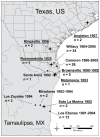Loss of genetic diversity among ocelots in the United States during the 20th century linked to human induced population reductions
- PMID: 24586737
- PMCID: PMC3935880
- DOI: 10.1371/journal.pone.0089384
Loss of genetic diversity among ocelots in the United States during the 20th century linked to human induced population reductions
Abstract
Ocelots (Leopardus pardalis) in the United States currently exhibit low levels of genetic diversity. One hypothesis for this observation is that habitat fragmentation, resulting from human induced changes in the landscape during the 20(th) century, created island populations with highly reduced gene flow and increased genetic drift and inbreeding. In an effort to investigate this, we used a portion of the mitochondrial control region and 11 autosomal microsatellite loci to examine historical levels of genetic diversity and infer temporal changes in ocelot populations between 1853 and 2005. Levels of genetic diversity were higher in historical ocelot populations than in extant populations from Texas. The earliest documented loss of mitochondrial haplotype diversity occurred at Laguna Atascosa National Wildlife Refuge. The second extant population inhabiting private lands in Willacy County retained higher levels of genetic diversity through the 1990s, but subsequently lost diversity over the next decade. A similar pattern was observed for autosomal microsatellite loci. This supports the argument that low levels of genetic diversity in Texas are related to human induced population reductions and fragmentation, both of which threaten the remaining ocelots in the United States. At this time, the best means of mitigating the continued erosion of genetic variation are translocation of individuals either from larger populations in Mexico to Texas, or between the Texas populations.
Conflict of interest statement
Figures



Similar articles
-
If you build it, will they come? A comparative landscape analysis of ocelot roadkill locations and crossing structures.PLoS One. 2022 May 3;17(5):e0267630. doi: 10.1371/journal.pone.0267630. eCollection 2022. PLoS One. 2022. PMID: 35503770 Free PMC article.
-
Genetic diversity of microsatellite loci in Leopardus pardalis, Leopardus wiedii and Leopardus tigrinus.Genet Mol Res. 2007 Jun 20;6(2):382-9. Genet Mol Res. 2007. PMID: 17624861
-
Trypanosoma cruzi and Incidental Sarcocystis spp. in Endangered Ocelots (Leopardus pardalis) of South Texas, USA.J Wildl Dis. 2021 Jul 1;57(3):667-671. doi: 10.7589/JWD-D-20-00169. J Wildl Dis. 2021. PMID: 34015810
-
Reduced Genetic Diversity and Increased Dispersal in Guigna (Leopardus guigna) in Chilean Fragmented Landscapes.J Hered. 2015;106 Suppl 1:522-36. doi: 10.1093/jhered/esv025. J Hered. 2015. PMID: 26245787
-
Population fragmentation leads to spatial and temporal genetic structure in the endangered Spanish imperial eagle.Mol Ecol. 2007 Feb;16(3):477-86. doi: 10.1111/j.1365-294X.2007.03147.x. Mol Ecol. 2007. PMID: 17257107
Cited by
-
A Comparative Analysis of Genetic Diversity and Structure in Jaguars (Panthera onca), Pumas (Puma concolor), and Ocelots (Leopardus pardalis) in Fragmented Landscapes of a Critical Mesoamerican Linkage Zone.PLoS One. 2016 Mar 14;11(3):e0151043. doi: 10.1371/journal.pone.0151043. eCollection 2016. PLoS One. 2016. PMID: 26974968 Free PMC article.
-
Highway Crossing Rates of Wild Felids Before, During, and After Wildlife Crossing Structure Installation.Ecol Evol. 2024 Dec 23;14(12):e70703. doi: 10.1002/ece3.70703. eCollection 2024 Dec. Ecol Evol. 2024. PMID: 39720638 Free PMC article.
-
Reduced Genetic Diversity and Increased Structure in American Mink on the Swedish Coast following Invasive Species Control.PLoS One. 2016 Jun 22;11(6):e0157972. doi: 10.1371/journal.pone.0157972. eCollection 2016. PLoS One. 2016. PMID: 27333328 Free PMC article.
-
Population and genetic outcomes 20 years after reintroducing bobcats (Lynx rufus) to Cumberland Island, Georgia USA.Ecol Evol. 2015 Oct 12;5(21):4885-95. doi: 10.1002/ece3.1750. eCollection 2015 Nov. Ecol Evol. 2015. PMID: 26640668 Free PMC article.
-
Ocelot Population Status in Protected Brazilian Atlantic Forest.PLoS One. 2015 Nov 11;10(11):e0141333. doi: 10.1371/journal.pone.0141333. eCollection 2015. PLoS One. 2015. PMID: 26560347 Free PMC article.
References
-
- Sunquist ME, Sunquist F (2002) Wild cats of the World. Chicago, Illinois: Univesity of Chicago Press.
-
- USFWS (1999) Endangered and Threatened Wildlife and Plants. Washington DC.
-
- Tewes ME, Everett DD (1986) Status and distribution of the endangered ocelot and jaguarundi in Texas. In: Miller SD, Everett DD, editors. Cats of the World: Biology, Conservation, and Management Washington, D.C.: National Wildlife Federation. 147–158.
-
- Murray JL, Gardner GL (1997) Leopardus pardalis . Mammalian Species 548: 1–10.
-
- Haines AM, Grassman LI, Tewes ME, Janecka JE (2006) First ocelot (Leopardus pardalis) monitored with GPS telemetry. European Journal of Wildlife Research 52: 216–218.
Publication types
MeSH terms
Substances
LinkOut - more resources
Full Text Sources
Other Literature Sources

